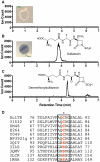Identification and Characterization of the Sulfazecin Monobactam Biosynthetic Gene Cluster
- PMID: 28017601
- PMCID: PMC5286544
- DOI: 10.1016/j.chembiol.2016.11.010
Identification and Characterization of the Sulfazecin Monobactam Biosynthetic Gene Cluster
Abstract
The monobactams, exemplified by the natural product sulfazecin, are the only class of β-lactam antibiotics not inactivated by metallo-β-lactamases, which confer bacteria with extended-spectrum β-lactam resistance. We screened a transposon mutagenesis library from Pseudomonas acidophila ATCC 31363 and isolated a sulfazecin-deficient mutant that revealed a gene cluster encoding two non-ribosomal peptide synthetases (NRPSs), a methyltransferase, a sulfotransferase, and a dioxygenase. Three modules and an aberrant C-terminal thioesterase (TE) domain are distributed across the two NRPSs. Biochemical examination of the adenylation (A) domains provided evidence that L-2,3-diaminopropionate, not L-serine as previously thought, is the direct source of the β-lactam ring of sulfazecin. ATP/PPi exchange assay also revealed an unusual substrate selectivity shift of one A domain when expressed with or without the immediately upstream condensation domain. Gene inactivation analysis defined a cluster of 13 open reading frames sufficient for sulfazecin production, precursor synthesis, self-resistance, and regulation. The identification of a key intermediate supported a proposed NRPS-mediated mechanism of sulfazecin biosynthesis and β-lactam ring formation distinct from the nocardicins, another NRPS-derived subclass of monocyclic β-lactam. These findings will serve as the basis for further biosynthetic research and potential engineering of these important antibiotics.
Keywords: antibiotic; biosynthesis; metallo-β-lactamase; natural product; non-ribosomal peptide synthetase; sulfazecin; sulfotransferase; β-lactam.
Copyright © 2017 Elsevier Ltd. All rights reserved.
Figures






Similar articles
-
Monobactam formation in sulfazecin by a nonribosomal peptide synthetase thioesterase.Nat Chem Biol. 2018 Jan;14(1):5-7. doi: 10.1038/nchembio.2526. Epub 2017 Nov 20. Nat Chem Biol. 2018. PMID: 29155429 Free PMC article.
-
One Ring to Fight Them All: The Sulfazecin Story.Cell Chem Biol. 2017 Jan 19;24(1):1-2. doi: 10.1016/j.chembiol.2017.01.001. Cell Chem Biol. 2017. PMID: 28107651
-
The structure of the monobactam-producing thioesterase domain of SulM forms a unique complex with the upstream carrier protein domain.J Biol Chem. 2024 Aug;300(8):107489. doi: 10.1016/j.jbc.2024.107489. Epub 2024 Jun 20. J Biol Chem. 2024. PMID: 38908753 Free PMC article.
-
Biosynthesis of active pharmaceuticals: β-lactam biosynthesis in filamentous fungi.Biotechnol Genet Eng Rev. 2010;27:1-32. doi: 10.1080/02648725.2010.10648143. Biotechnol Genet Eng Rev. 2010. PMID: 21415891 Review.
-
Alpha-aminoadipyl-cysteinyl-valine synthetases in beta-lactam producing organisms. From Abraham's discoveries to novel concepts of non-ribosomal peptide synthesis.J Antibiot (Tokyo). 2000 Oct;53(10):1008-21. doi: 10.7164/antibiotics.53.1008. J Antibiot (Tokyo). 2000. PMID: 11132945 Review.
Cited by
-
Colorimetric Determination of Adenylation Domain Activity in Nonribosomal Peptide Synthetases by Using Chrome Azurol S.Chembiochem. 2023 Mar 1;24(5):e202200668. doi: 10.1002/cbic.202200668. Epub 2023 Jan 26. Chembiochem. 2023. PMID: 36511946 Free PMC article.
-
The biosynthetic implications of late-stage condensation domain selectivity during glycopeptide antibiotic biosynthesis.Chem Sci. 2018 Oct 10;10(1):118-133. doi: 10.1039/c8sc03530j. eCollection 2019 Jan 7. Chem Sci. 2018. PMID: 30713624 Free PMC article.
-
Efficient rational modification of non-ribosomal peptides by adenylation domain substitution.Nat Commun. 2020 Sep 11;11(1):4554. doi: 10.1038/s41467-020-18365-0. Nat Commun. 2020. PMID: 32917865 Free PMC article.
-
Nonribosomal Peptide Synthesis Definitely Working Out of the Rules.Microorganisms. 2022 Mar 7;10(3):577. doi: 10.3390/microorganisms10030577. Microorganisms. 2022. PMID: 35336152 Free PMC article. Review.
-
Comparison of Antibiotic Resistance Mechanisms in Antibiotic-Producing and Pathogenic Bacteria.Molecules. 2019 Sep 21;24(19):3430. doi: 10.3390/molecules24193430. Molecules. 2019. PMID: 31546630 Free PMC article. Review.
References
-
- Aoki H, Sakai H, Kohsaka M, Konomi T, Hosoda J. Nocardicin A, a new monocyclic β-lactam antibiotic, I. discovery, isolation and characterization. J. Antibiot. 1976;29:492–500. - PubMed
-
- Araoka H, Baba M, Tateda K, Ishii Y, Oguri T, Okuzumi K, Oishi T, Mori S, Mitsuda T, Moriya K, et al. Monobactam and aminoglyco-side combination therapy against metallo-β-lactamase-producing multidrug-resistant Pseudomonas aeruginosa screened using a `break-point checkerboard plate'. Jpn. J. Infect. Dis. 2012;65:84–87. - PubMed
-
- Asai M, Haibara K, Muroi M, Kintaka K, Kishi T. Sulfazecin, a novel β-lactam antibiotic of bacterial origin. Isolation and chemical characterization. J. Antibiot. 1981;34:621–627. - PubMed
-
- Bachmann BO, Ravel J. In silico prediction of microbial secondary metabolic pathways from DNA sequence data. Methods Enzymol. 2009;458:181–217. - PubMed
MeSH terms
Substances
Grants and funding
LinkOut - more resources
Full Text Sources
Other Literature Sources
Molecular Biology Databases

